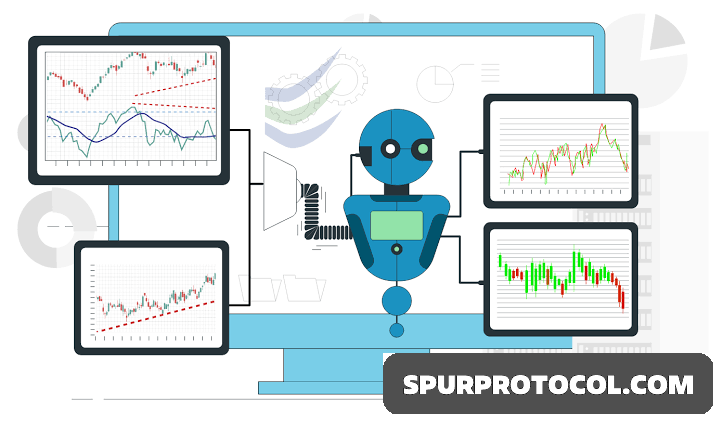What is Algorithmic Trading
- Algorithmic trading strategies involve making trading decisions based on pre-set rules that are programmed into a computer.
- A trader or investor writes code that executes trades on behalf of the trader or investor when certain conditions are met.
How Algorithmic Trading Works
- Algorithmic trading, involves the use of automated systems programmed to follow defined sets of instructions to place trades.
- These instructions are usually based on time, price, volume, or other market-related variables.
- Traders use algorithms to identify potential trading opportunities and execute orders at optimal speeds.
- The main objective is to remove human emotions from the trading process, improve efficiency, and reduce transaction costs.
Key elements of algorithmic trading
1. Rule-based logic
Algorithms are written using specific conditions like moving averages, price levels, or technical indicators.
2. Speed and accuracy
Trades are executed in milliseconds, helping capture opportunities that manual traders may miss.
3. Pre-set strategies
Examples include arbitrage, trend following, or mean reversion, all automated based on real-time data.
4. Market scanning
The system continuously monitors multiple securities across markets to trigger trades when conditions are met.
5. Backtesting
Strategies are tested using historical data to assess reliability before real capital is deployed.
Algorithmic Trading Strategies
1. Trend-Following Strategies
- These strategies focus on identifying and trading based on established market trends, such as moving averages or price level movements.
- They are straightforward to implement because they don't require predicting future prices; instead, they execute trades when specific trends are detected.
2. Arbitrage-Related Strategies
- Exploits price differences of the same asset in different markets by buying low in one market and selling high in another, capturing the spread as a risk-free profit.
- Algorithms can efficiently identify and execute these opportunities, often in real-time, across various markets, including stocks and futures.
3. Index Fund Rebalancing Strategies
- Algorithms can predict and trade ahead of rebalancing events, capturing small, reliable profits from price movements associated with the adjustments.
4. Mathematical Model-Based Strategies
- These strategies use complex mathematical models, such as the delta-neutral strategy, which balances opposing positions in options and their underlying assets to minimise risk.
- These strategies rely on precise mathematical relationships, allowing for sophisticated risk management and profit generation through algorithmic trading.
5. Mean Reversion Strategies
- Based on the principle that asset prices will revert to their historical average after deviating significantly.
- Algorithms can automatically buy or sell when prices move outside a defined range, capitalising on the expected return to the mean.
6. Volume-Weighted Average Price (VWAP) Strategies
- This strategy breaks down large orders into smaller ones, executing them throughout the day to achieve an average price that aligns with the market's volume profile.
- This strategy reduces the market impact of large trades, aiming to minimise costs by matching the average market price.
7. Time-Weighted Average Price (TWAP) Strategies
- Similar to VWAP, but focuses on time rather than volume, dividing orders evenly across a specified period to avoid market impact.
- TWAP is ideal for executing large trades gradually, ensuring the average price paid is close to the overall market price during the trade window.
8. Percentage of Volume (POV) Strategies
- These strategies adjust the size of partial orders based on a predefined ratio of the total market volume, allowing for dynamic participation as market conditions change.
- This strategy can be fine-tuned to increase or decrease participation in response to price movements, ensuring optimal trade execution.
9. Implementation Shortfall Strategies
- These strategies aim to minimise the total cost of executing an order by balancing the immediate cost against potential future gains or losses.
- The algorithm adjusts its trading pace based on real-time market conditions, increasing participation when prices are favourable and slowing down when not
Advantages of Algo Trading
1. Best Execution
Trades are often executed at the best possible prices.
2. Low Latency
Trade order placement is instant and accurate there is a high chance of execution at the desired levels.
3. Reduced transaction costs.
4. Simultaneous automated checks on multiple market conditions.
5. No Human Error
Reduced risk of manual errors or mistakes when placing trades. Also negates human traders; tendency to be swayed by emotional and psychological factors.
6. Backtesting
Algo-trading can be backtested using available historical and real-time data to see if it is a viable trading strategy.
Disadvantages of Algo Trading
1. Algorithms may fail due to software bugs or connectivity issues.
2. Overfitting models based on past data can lead to poor performance.
3. High market volatility can trigger unexpected outcomes.
4. Increased competition can diminish profitability for algo traders.
5. Regulatory changes can impact the effectiveness of trading strategies.

